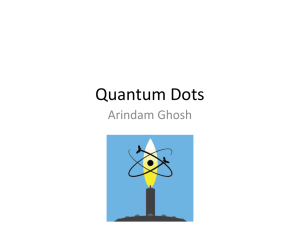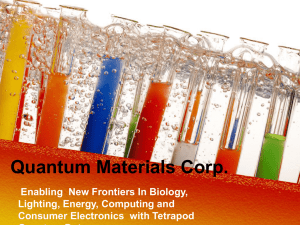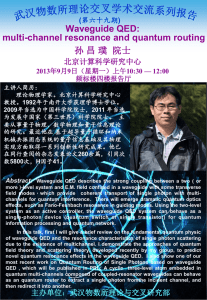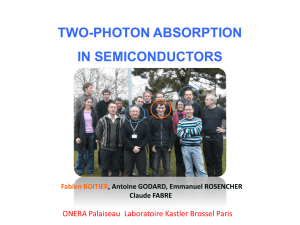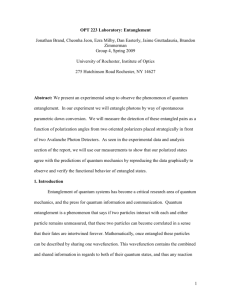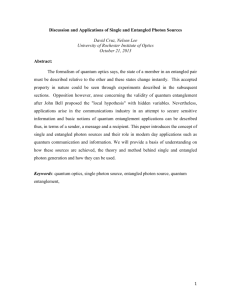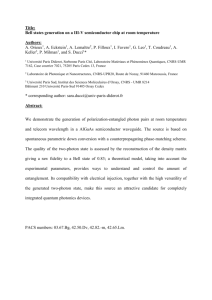Quantum Optics
advertisement
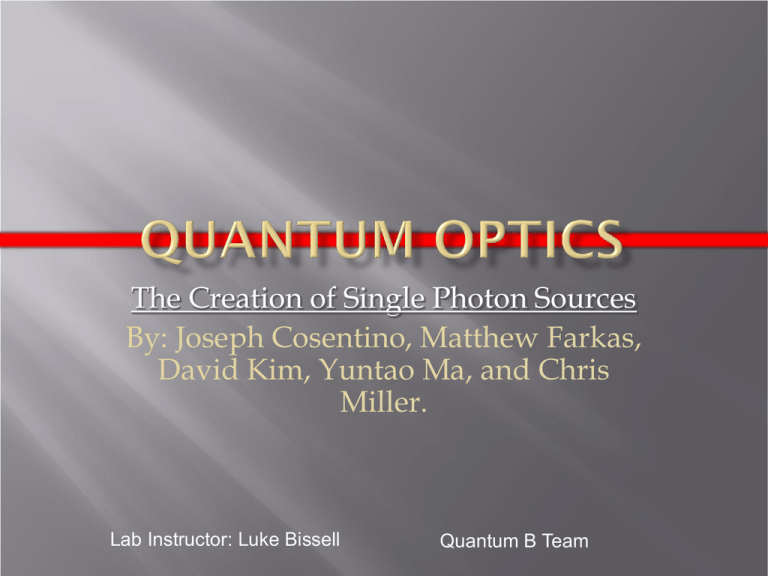
The Creation of Single Photon Sources By: Joseph Cosentino, Matthew Farkas, David Kim, Yuntao Ma, and Chris Miller. Lab Instructor: Luke Bissell Quantum B Team Single photon sources have already been created and somewhat utilized but they are not very efficient. Luke Bissell’s Phd research goals are to create more efficient single photon sources and to find sources that emit polarized photons. The first method of obtaining single photon sources was to attenuate a laser to one photon. This does not work, because in actuality, the laser is emitting an AVERAGE of one photon. Sometimes the laser will emit two, or none at all. This method is not efficient. Luke Bissell (our lab instructor) is searching for an efficient emitter of single photons and polarized single photons. There are number of other theoretical methods that can be used to create single photons: Quantum Dots, Single Atoms, Single Molecules, or Color centers in a diamond (nitrogen vacancy). We used quantum dots, they are nanocrystals that are not difficult to create and manipulate. They are simply the most efficient method of going about the research. “Individual color centers in diamond are promising for near-term quantum technologies including quantum key distribution and metrology. Here we show fabrication of an as-yet uncharacterized nickel-related complex in diamond which has photophysical properties surpassing the two main-stay centers for singlephoton applications, namely, the nitrogen-vacancy and the nickel-nitrogen complex (NE8) center. This center was fabricated using focused ion-beam implantation of nickel into isolated chemical vapor-deposited diamond crystals. A possible correlation of the center to a Ni/Si complex is substantiated by a coimplantation of Ni and Si into a pure bulk diamond. Room-temperature photoluminescence studies reveal a narrow emission in the near infrared region centered at 768 nm with a lifetime as short as 2 ns.” Courtesy of: http://prb.aps.org/abstract/PRB/v79/i23/e235316 Quantum Dot’s are small crystalline structures (nanocrystals) that have the properties of single atoms of two energy levels. Since they act as single atoms, they will emit a single photon when excited. Isolating these nano-crystals is difficult. NeV Single Photon coincidence counts 0 interphoton times 76 MHz repetition rate, CW excitation ~6 ps pulsed-laser at 532 nm excitation at 532 nm Non-Antibunching 16 14 12 10 Series1 8 Series2 6 4 2 0 0 20 40 60 80 100 120 30 Antibunching 25 20 Series1 15 Series2 10 5 0 -60 -40 -20 0 20 40 60 Semiconductor nanocrystals that behave as 2 level atoms with size-dependent properties. Electrons require a specific amount of energy to jump the bandgap. Electrons emit a photon when they fall to lower energy levels. Why can’t we attenuate a laser down to the single photon level? The average number of photons emitted is 1. The actual number is greater than 1 or is 0. Do not get 1 photon at a time as in Quantum Dots. L. J. Bissell, S. G. Lukishova, A. W. Schmid, et al., Chiral Photonic Bandgap Microcavities with Single Colloidal Semiconductor Quantum Dots," Proceedings of SPIE, Submitted. The laser is a diode-pumped solid-state with 532nm wavelength, 6 ps pulse duration and 76 MHz pulse repetition rate. There are three major types of information that we gathered in this lab: • • • The intensity of an area of Quantum Dot solution The emitted photon counts of particular Quantum Dots And in the case of the CLC solutions the wavelength spectrum of the emitted photons We used a Labview application built by a former UR grad student Creates images of what the two APDs detect on their imaging area using the images’ intensity data Also used shows the intensity data of a particular point within the image over time. (histogram) Used to determine the location of potential sites of individual Quantum Dots 99.0 99.0 21 60.0 1000 100 800 88 941 1000 100 800 88 600 75 400 62 200 50 62 38 25 25 12 12 12 25 38 50 62 75 88 400 200 50 5 0 600 75 38 0 15.0 0 100 5 0 12 25 38 50 62 APD1 APD2 1400.0 1200.0 1000.0 800.0 600.0 400.0 200.0 0.0 0.0 50000.0 100000.0 150000.0 200000.0 t im e (m s) 250000.0 300000.0 350000.0 400000.0 75 88 100 November 12th, 705nm Quantum Dots on glass, 20nM concentration (Histogram and Intensity Images) 16.0 9.0 59 60 100 50 88 40 75 30 20 62 10 50 0 38 1 25 12 0 0 12 25 38 50 62 75 88 100 We used proprietary software called TimeHarp which is made specifically for counting individual photons The software essentially takes the same information that is displayed in Labview and plots the number of counts based on the delay in time between the counts Used to determine whether a given Quantum Dot is anti-bunched or not. 25 20 15 Series1 Series2 10 5 0 0 20 40 60 80 100 120 November 12th, 705nm Quantum Dots on glass, 20nM concentration (Count Plot) We used some proprietary software called Andor Solis for Imaging: Gathered and displayed data collected by the EMCCD camera about a chosen quantum dot’s emission spectrum Used in conjunction with a rotating polarizer to determine if the CLC containing the QD is polarizing the QD’s emissions (as is desired) A sample with a linear polarizer rotated at 43 degrees in the imaging path Same sample with a linear polarizer rotated at 135 degrees in the imaging path 16 12.0 35.0 256 492 100 400 88 300 2 75 200 62 100 50 3 38 25 12 0 0 12 25 38 50 62 75 88 100 30 25 20 Series1 15 Series2 10 5 0 -60 -40 -20 0 20 40 60 Polarizer at 43 degrees Polarizer at 135 degrees That the spot in the sample tested is a quantum dot That this particular quantum dot is a single, anti-bunched dot And that the CLC is polarizing the light Quantum Cryptography =1 =1 =0 =0 + Alice or x Eve Bob N. Gisin, et al., Rev. Mod. Phys. 74, 145-195 (2002)



